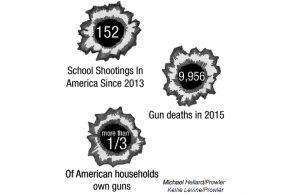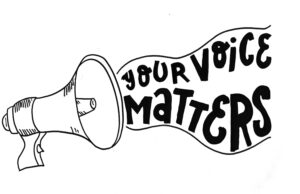Gun Control: Targeting the issue
A virus is spreading through our nation, infecting our schools, and killing America’s youth. Its name is gun violence.
On Oct. 1, a shooting at Umpqua Community College in Roseburg, Ore. left ten dead and nine injured. “Somehow, this has become routine,” President Barack Obama said in a national address later that day. “We’ve become numb to this.”
According to CNN, 15 major incidents involving gun violence on or near a school campus have occurred since 2012. Our nation needs to take action to address this horrifying “routine” of school massacres, so schools nationwide are not left vulnerable. Protecting the lives of American students and educators must go beyond the safety protocols that merely aim at mitigating casualty.
After a mass shooting, the public typically calls for either better care for those with mental illnesses or for stricter gun control. Some argue that if we can identify patients with violent tendencies early on, address their illnesses, and alert authorities, many shootings could be prevented. However, based on the profiles of past shooters, no singular set of symptoms categorize all perpetrators of gun violence, not to mention that for every shooter with some psychological problem, there are dozens of others with the same illness who never commit any crime. Additionally, it’s impractical to force people to involuntarily commit themselves to mental counseling. Therefore, we should strive to better our mental health care, but that alone will not have a major impact in reducing school shootings.
Sometimes school shooters are students who are in a possession of a firearm, but who do not have a history of mental illness, and fire their weapon in an on campus altercation. Take, for example, an incident that occurred last October at Langston Hughes High School in Fairburn, Ga., where an 18-year-old student with a gun on his person got into an argument with a 17-year-old student from another school during a homecoming football game and subsequently shot and killed him. Situations like these affirm the idea that though the country should strive to better its mental health care, that alone will not guarantee protection for America’s youth.
Guns are a more definite aspect of shootings, but the history of gun control is a long, complicated and emotionally charged one. Gun rights advocates cite the second amendment as the Constitutional protection of their right to own firearms. But when the Founding Fathers included the second amendment in the Bill of Rights, they did so because citizens of the new frontier needed protection not against their own neighbors, but rather against British soldiers, other peoples, and, most importantly, their own fresh revolutionary government in the event it turned to tyranny. After more than 200 years, our government’s check and balance system has functioned well to protect citizens’ rights, and an effective law and order system ensures their safety. The circumstances for the second amendment have thus drastically changed.
In his speech, President Obama has endorsed the Australian form of gun control. Within two weeks after a 1996 massacre in Tasmania that left 35 dead, the Australian government passed legislation that banned all semi-automatic and rapid-fire rifles and instituted a mandatory buyback program for the aforementioned firearms already in circulation. Almost two decades later, the rate of gun-related homicides in Australia has decreased 59 percent to 0.14 per 100,000 population, which is more than 21 times lower than the United States’ rate of 2.97 for every 100,000 population. More impressively, there have not been any incidents of mass shooting since. Australia’s model is a worthy precedent to consider for our own country. According to the Gallup Poll, more than one third of American households own guns and the top three reasons for gun ownership are for self-protection, hunting and recreational/target shooting. Banning assault weapons will not affect individual owners’ needs for these purposes; rather, it will alleviate regular gun owners’ worries of being outgunned by criminals, and it will certainly diminish the potential damage of a school shooting because mass killing is hard to achieve without these high powered weapons.
Gun control and gun rights should not be pitted against each other. The solution to this problem will lie in a multifaceted compromise that includes heightened attention to public mental healthcare and working gun control legislation.
Let’s come together as a nation and start a serious dialogue that will lead to action in our capital. Just as we updated our Constitution to incorporate minority rights and suffrage for all, Congress needs to create gun legislation reform in the context of modern times and place restrictions on assault firearms so our campuses and our nation can stay safe and rid of this gruesome virus.




